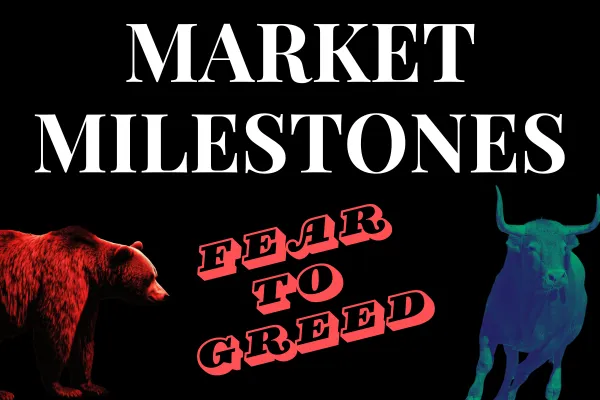
Market Milestones: Fear to Greed
Sentiment in the markets flips on a dime. Just one month ago, we were at a 3—deep in “extreme fear” on the Fear & Greed Index. Today, we’re at 62, firmly in “greed.”

Since last November, one word has consistently defined this newsletter: early. I was early calling for a market pullback in November and moved fully to cash and Bitcoin in December—76 days before the equity top. I was early again trying to call the bottom, buying in early March, only to get stopped out when the market broke down further. Then in late March and early April, I started getting bullish again—and Jerremy Newsome went fully back into the market on April 7th. So at least one of us nailed the exact low.
I stayed bullish and kept buying until April 23rd, when I began peeling off profits and watching for a pullback. I took more off the table on April 29th as SPY hit my first major target at $555.55, and then again on May 2nd as QQQ tagged its 200-day SMA. Now, 13 days after I started waving the caution flag—playing the boy who called dip—there’s hardly a bear in sight, and a pullback seems like the last thing on anyone’s radar.
QQQ

Maybe we do go straight up from here on the back of great trade deals, rate cuts, and all the other good news. But the macro environment today isn’t 2020—we’re not set up for another V-bottom straight into new all-time highs. I’ve got multiple technical signals pointing to a dip ahead, so I’m sticking to my main thesis. QQQ hasn’t quite hit my next big target at $500 yet, so I still see room for some upside into next week before the larger retest sets in.
I’m almost always going to be early. I won’t consistently call exact tops or bottoms. Trading isn’t about perfection; it’s about catching a healthy chunk of the middle and protecting capital from major drawdowns.
With QQQ pushing into heavy resistance after a 22% rally in just one month—and sentiment now heavily tilted bullish—I see this as a moment to sell into strength, not chase breakouts. I could absolutely be wrong (I often am), but the probability of a 5–10% pullback in QQQ is quite high in my opinion. I’m not calling for a crash to new lows, although that set up does remain on the table. I think a higher low followed by a summer rally is far more likely. If we start gapping down hard on big volume, my view may shift. But until then, I’m firmly in the “sell now to buy the dip later” camp.
SPY

Now onto BTC—where dips sometimes never come, and max pain for the most market participants often looks like a vertical green candle. As I write this, BTC is trading at $103,000—up nearly 40% from its April lows and 22% since I called out it’s oversold RSI signal. I’ve written extensively about how RSI dropping into the 28 range has historically been a strong buy signal. This time, we saw divergence on two separate lower lows—both great buying opportunities.
Even if someone didn’t nail the bottom and instead bought around $84,000—a level we targeted for months in the RLT Newsletter—they’re still up 23%, and a move to all-time highs would take that to 30%.
BTCUSD

BTC is clearly showing five waves off the low, which looks like the first wave of a larger fifth wave. If that’s the case, it’s a strong signal that this final leg could easily push toward my Target 2 by late summer. I’ll be watching for a second wave pullback into the $96K–$85K zone, with $92K as the key level on my radar. Historically, BTC tends to offer shallow dips after re-confirming an uptrend—rarely giving dip buyers the satisfaction of a deep retrace.
My upside targets for this move are $124,000, $139,876.54, and $155,555.55, though those could adjust depending on how the second wave pullback plays out. I’ve been calling $124K a high-probability target for months, but Target 2 is starting to look increasingly likely. If we get that dip back to $92K, the risk-reward into $124K offers a solid 30% upside.
So I guess the question is—if you had one shot, one opportunity to seize all the BTC you ever wanted, would you capture it, and buy the dip?





